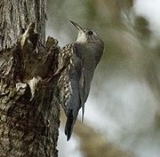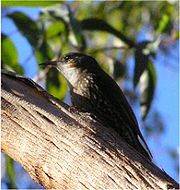
White-throated Treecreeper
Encyclopedia
The White-throated Treecreeper (Cormobates leucophaea) is an Australian treecreeper found in the forests of eastern Australia
. It is unrelated to the northern hemisphere treecreeper
s. It is a small passerine
bird with predominantly brown and white plumage and measuring some 15 cm
(6 in
) long on average. It is insectivorous, eating mainly ants. Unlike treecreepers of the genus Climacteris, the White-throated Treecreeper does not engage in cooperative breeding.
in 1802 as Certhia leucophaea. For many years it was classified in the genus Climacteris.
The generic
name is derived from the Ancient Greek
kormos 'trunk
of a tree', and 'batēs' from the verb 'to go' or 'to travel', and refers to its mode of walking up and down trees. Its specific name is derived from the Ancient Greek leuko- 'white' and phaios 'dun' or 'dusky', and refers to its plumage. Some guidebooks have the binomial
name written as Cormobates leucophaeus, however a review in 2001 rules that the genus name was feminine, hence leucophaea is the correct specific name.
The Papuan Treecreeper
(Cormobates placens) was previously considered a subspecies but is now recognized as a separate species, although molecular studies have yet to be done on the two taxa.
 Measuring 13-17 cm
Measuring 13-17 cm
(5-7 in
) in length with a wingspan of 19–26 cm (8–10 in), averaging 23 cm (9 in), and averaging 22 g
(0.8 oz
) in weight, it has a white throat and breast and barred dark-brown and white belly and flanks. The upperparts and wings are a dark greyish brown, with a buff patch visible on the wings. Unlike other treecreepers, it does not have a pale eyebrow. The bill and feet are black. The female has a pale orange-brown patch on the cheek. Immature birds have an orange-brown rump and white markings on the scapulars.
The call is a shrill peeping.
. Wet sclerophyll forest and rainforest is the preferred habitat.
It is Protected in Australia under the National Parks and Wildlife Act, 1974.
showed the White-throated Treecreeper preferred foraging on the rough-barked eucalypt, the Red Stringybark (Eucalyptus macrorhyncha
), rather than the smooth barked species, the Inland Scribbly Gum (Eucalyptus rossii
). Birds would glean (take prey while bird is perched) and peer, as well as drill in dead wood, for insects.
s is laid. Sparsely spotted with dark purple- or red-brown, they measure 23 x 18 mm.
Australia
Australia , officially the Commonwealth of Australia, is a country in the Southern Hemisphere comprising the mainland of the Australian continent, the island of Tasmania, and numerous smaller islands in the Indian and Pacific Oceans. It is the world's sixth-largest country by total area...
. It is unrelated to the northern hemisphere treecreeper
Treecreeper
The treecreepers are a family, Certhiidae, of small passerine birds, widespread in wooded regions of the Northern Hemisphere and sub-Saharan Africa. The family contains ten species in two genera, Certhia and Salpornis...
s. It is a small passerine
Passerine
A passerine is a bird of the order Passeriformes, which includes more than half of all bird species. Sometimes known as perching birds or, less accurately, as songbirds, the passerines form one of the most diverse terrestrial vertebrate orders: with over 5,000 identified species, it has roughly...
bird with predominantly brown and white plumage and measuring some 15 cm
Centimetre
A centimetre is a unit of length in the metric system, equal to one hundredth of a metre, which is the SI base unit of length. Centi is the SI prefix for a factor of . Hence a centimetre can be written as or — meaning or respectively...
(6 in
Inch
An inch is the name of a unit of length in a number of different systems, including Imperial units, and United States customary units. There are 36 inches in a yard and 12 inches in a foot...
) long on average. It is insectivorous, eating mainly ants. Unlike treecreepers of the genus Climacteris, the White-throated Treecreeper does not engage in cooperative breeding.
Taxonomy
It was first described by ornithologist John LathamJohn Latham (ornithologist)
John Latham was an English physician, naturalist and author. He was born at Eltham in Kent, and was the eldest son of John Latham, a surgeon there, and his mother was a descendant of the Sothebys, in Yorkshire....
in 1802 as Certhia leucophaea. For many years it was classified in the genus Climacteris.
The generic
Genus
In biology, a genus is a low-level taxonomic rank used in the biological classification of living and fossil organisms, which is an example of definition by genus and differentia...
name is derived from the Ancient Greek
Ancient Greek
Ancient Greek is the stage of the Greek language in the periods spanning the times c. 9th–6th centuries BC, , c. 5th–4th centuries BC , and the c. 3rd century BC – 6th century AD of ancient Greece and the ancient world; being predated in the 2nd millennium BC by Mycenaean Greek...
kormos 'trunk
Trunk (botany)
In botany, trunk refers to the main wooden axis of a tree that supports the branches and is supported by and directly attached to the roots. The trunk is covered by the bark, which is an important diagnostic feature in tree identification, and which often differs markedly from the bottom of the...
of a tree', and 'batēs' from the verb 'to go' or 'to travel', and refers to its mode of walking up and down trees. Its specific name is derived from the Ancient Greek leuko- 'white' and phaios 'dun' or 'dusky', and refers to its plumage. Some guidebooks have the binomial
Binomial nomenclature
Binomial nomenclature is a formal system of naming species of living things by giving each a name composed of two parts, both of which use Latin grammatical forms, although they can be based on words from other languages...
name written as Cormobates leucophaeus, however a review in 2001 rules that the genus name was feminine, hence leucophaea is the correct specific name.
The Papuan Treecreeper
Papuan Treecreeper
The Papuan Treecreeper is a species of bird in the Climacteridae family. It was previously considered a subspecies of the White-throated Treecreeper .It is found in Indonesia and Papua New Guinea.-References:...
(Cormobates placens) was previously considered a subspecies but is now recognized as a separate species, although molecular studies have yet to be done on the two taxa.
Subspecies
Five subspecies are recognised:- C. l. leucophaea, the nominate subspecies, occurs in southeastern Australia into southern Queensland.
- C. l. grisescens is found in the Mount Lofty RangesMount Lofty RangesThe Mount Lofty Ranges are the range of mountains just to the east of Adelaide in South Australia.-Location and description:The Mount Lofty Ranges stretch from the southernmost point of the Fleurieu Peninsula at Cape Jervis northwards for over before petering out north of Peterborough...
, in South Australia. - C. l. intermedius is restricted to the Clark-Connors Ranges in Central Queensland.
- C. l. metastasis, described by Richard SchoddeRichard SchoddeRichard Schodde, OAM is an Australian botanist and ornithologist.Schodde studied at the University of Adelaide where he received a BSc in 1960 and a PhD in 1970. During the 1960s he was a botanist with the CSIRO Division of Land Research and Regional Survey in Papua New Guinea...
in 1989, is found in southeastern Queensland and northeastern New South Wales. - C. l. minor occurs in northern Queensland. It was originally described in 1891 after being collected near CairnsCairns, QueenslandCairns is a regional city in Far North Queensland, Australia, founded 1876. The city was named after William Wellington Cairns, then-current Governor of Queensland. It was formed to serve miners heading for the Hodgkinson River goldfield, but experienced a decline when an easier route was...
.
Description

Centimetre
A centimetre is a unit of length in the metric system, equal to one hundredth of a metre, which is the SI base unit of length. Centi is the SI prefix for a factor of . Hence a centimetre can be written as or — meaning or respectively...
(5-7 in
Inch
An inch is the name of a unit of length in a number of different systems, including Imperial units, and United States customary units. There are 36 inches in a yard and 12 inches in a foot...
) in length with a wingspan of 19–26 cm (8–10 in), averaging 23 cm (9 in), and averaging 22 g
Gram
The gram is a metric system unit of mass....
(0.8 oz
Ounce
The ounce is a unit of mass with several definitions, the most commonly used of which are equal to approximately 28 grams. The ounce is used in a number of different systems, including various systems of mass that form part of the imperial and United States customary systems...
) in weight, it has a white throat and breast and barred dark-brown and white belly and flanks. The upperparts and wings are a dark greyish brown, with a buff patch visible on the wings. Unlike other treecreepers, it does not have a pale eyebrow. The bill and feet are black. The female has a pale orange-brown patch on the cheek. Immature birds have an orange-brown rump and white markings on the scapulars.
The call is a shrill peeping.
Distribution and habitat
The White-throated Treecreeper is found from the Gulf St Vincent in South Australia, through Victoria, and eastern New South Wales and southeastern Queensland, with an area further north from Mount Spec to CooktownCooktown, Queensland
Cooktown is a small town located at the mouth of the Endeavour River, on Cape York Peninsula in Far North Queensland where James Cook beached his ship, the Endeavour, for repairs in 1770. At the 2006 census, Cooktown had a population of 1,336...
. Wet sclerophyll forest and rainforest is the preferred habitat.
It is Protected in Australia under the National Parks and Wildlife Act, 1974.
Feeding
The White-throated Treecreeper is predominantly insectivorous, eating mainly ants, although will eat also nectar. A 2007 study in the Australian Capital TerritoryAustralian Capital Territory
The Australian Capital Territory, often abbreviated ACT, is the capital territory of the Commonwealth of Australia and is the smallest self-governing internal territory...
showed the White-throated Treecreeper preferred foraging on the rough-barked eucalypt, the Red Stringybark (Eucalyptus macrorhyncha
Eucalyptus macrorhyncha
Eucalyptus macrorhyncha, commonly known as Red Gum, Red Stringybark, Cannons Stringybark or Capertee Stringybark, is a small to medium-sized tree with rough, thick fibrous and stringy, dark-brown bark....
), rather than the smooth barked species, the Inland Scribbly Gum (Eucalyptus rossii
Eucalyptus rossii
Eucalyptus rossii, commonly known as Inland Scribbly Gum, Western Scribbly Gum, Snappy Gum or White Gum, is a smooth-barked eucalypt of eastern Australia....
). Birds would glean (take prey while bird is perched) and peer, as well as drill in dead wood, for insects.
Breeding
Unlike treecreepers of the genus Climacteris, the White-throated Treecreeper does not engage in cooperative breeding. The breeding season is August to December with one brood laid. The cup-shaped nest is composed of fur, hair, feathers, and moss in a hollow in a tree 4–5 m (12–16 ft) above the ground. A clutch of two or three creamy-white oval eggEgg (biology)
An egg is an organic vessel in which an embryo first begins to develop. In most birds, reptiles, insects, molluscs, fish, and monotremes, an egg is the zygote, resulting from fertilization of the ovum, which is expelled from the body and permitted to develop outside the body until the developing...
s is laid. Sparsely spotted with dark purple- or red-brown, they measure 23 x 18 mm.
External links
- White-throated Treecreeper videos, photos & sounds on the Internet Bird Collection

